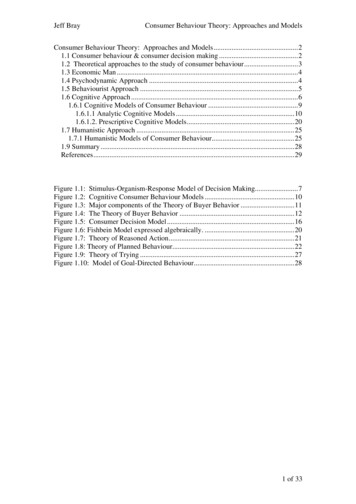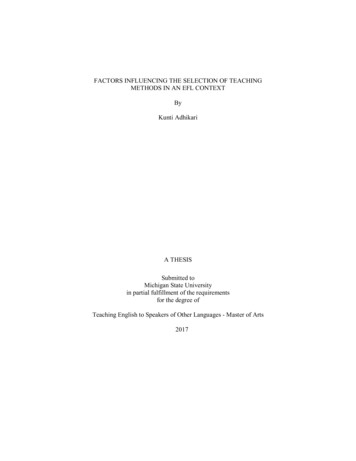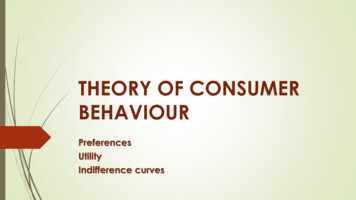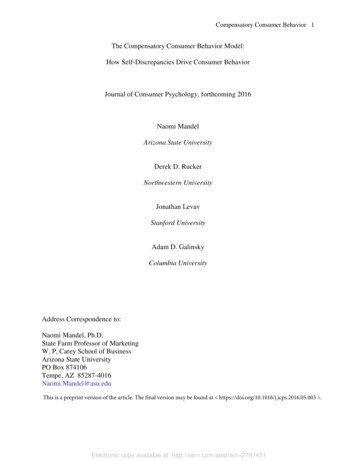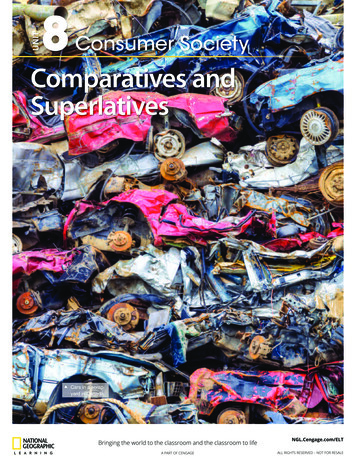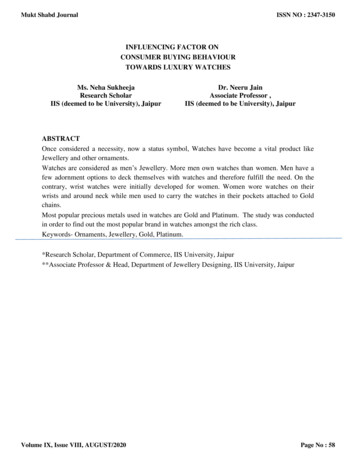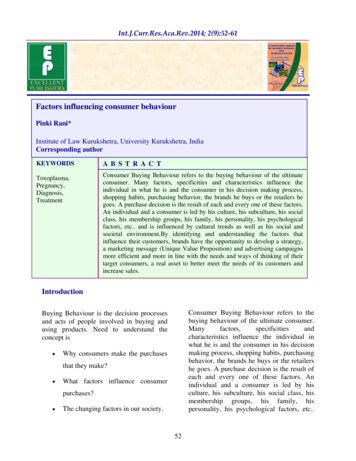
Transcription
Factors influencing consumer behaviourPinki Rani*Institute of Law Kurukshetra, University Kurukshetra, IndiaCorresponding authorKEYWORDSA B S T R A C TToxoplasma,Pregnancy,Diagnosis,TreatmentConsumer Buying Behaviour refers to the buying behaviour of the ultimateconsumer. Many factors, specificities and characteristics influence theindividual in what he is and the consumer in his decision making process,shopping habits, purchasing behavior, the brands he buys or the retailers hegoes. A purchase decision is the result of each and every one of these factors.An individual and a consumer is led by his culture, his subculture, his socialclass, his membership groups, his family, his personality, his psychologicalfactors, etc. and is influenced by cultural trends as well as his social andsocietal environment.By identifying and understanding the factors thatinfluence their customers, brands have the opportunity to develop a strategy,a marketing message (Unique Value Proposition) and advertising campaignsmore efficient and more in line with the needs and ways of thinking of theirtarget consumers, a real asset to better meet the needs of its customers andincrease sales.IntroductionConsumer Buying Behaviour refers to thebuying behaviour of the ultimate cs influence the individual inwhat he is and the consumer in his decisionmaking process, shopping habits, purchasingbehavior, the brands he buys or the retailershe goes. A purchase decision is the result ofeach and every one of these factors. Anindividual and a consumer is led by hisculture, his subculture, his social class, hismembership groups, his family, hispersonality, his psychological factors, etc.Buying Behaviour is the decision processesand acts of people involved in buying andusing products. Need to understand theconcept isWhy consumers make the purchasesthat they make?What factors influence consumerpurchases?The changing factors in our society.52
and is influenced by cultural trends as wellas his social and societal environment.their impact is essential as marketing mixstrategies can be developed to appeal to thepreferences of the target market.By identifying and understanding the factorsthat influence their customers, brands havethe opportunity to develop a strategy, amarketingmessage(UniqueValueProposition) and advertising campaignsmore efficient and more in line with theneeds and ways of thinking of their targetconsumers, a real asset to better meet theneeds of its customers and increase sales.When purchasing any product, a consumergoes through a decision process. Thisprocess consists of up to five stages:Stage 1: problem recognition,Stage 2: information search,Stage 3: evaluation of alternatives,Stage 4: purchase decisionStage 5: post purchase behaviour.The length of this decision process will vary.A consumer may not act in isolation in thepurchase, but rather may be influenced byany of several people in various roles. Thenumber of people involved in the buyingdecision increases with the level ofinvolvement and complexity of the buyingdecisionbehaviour.Consumer s buyer behaviour and theresulting purchase decision are stronglyinfluenced by cultural, social, personal andpsychologicalcharacteristics.Anunderstanding of the influence of thesefactors is essential for marketers in order todevelop suitable marketing mixes to appealto the target customer.Consumer behavior refers to the selection,purchase and consumption of goods andservices for the satisfaction of their wants.There are different processes involved in theconsumer behavior. Initially the consumertries to find what commodities he would liketo consume, then he selects only thosecommodities that promise greater utility.After selecting the commodities, theconsumer makes an estimate of the availablemoney which he can spend. Lastly, theconsumer analyzes the prevailing prices ofcommodities and takes the decision aboutthe commodities he should consume.Meanwhile, there are various other factorsinfluencing the purchases of *Pinki Rani,Assistant, LIC, Kurukshetra.Cultural Factors - Culture and societalenvironmentConsumer such as social, cultural, personaland psychological. The explanation of thesefactors is given below.Culture is crucial when it comes tounderstanding the needs and behaviors of anindividual. Basically, culture is the part ofevery society and is the important cause ofperson wants and behavior. The influence ofculture on buying behavior varies fromcountry to country therefore marketers haveto be very careful in analyzing the culture ofdifferent groups, regions or even countries.Throughout his existence, an individual willbe influenced by his family, his friends, hiscultural environment or society that willteach him values, preferences as well asConsumer s buyer behaviour is influencedby four major factors:1) Cultural,2) Social,3) Personal,4) Psychological.These factors cause consumers to developproduct and brand preferences. Althoughmany of these factors cannot be directlycontrolled by marketers, understanding of53
common behaviors to their own culture. Fora brand, it is important to understand andtake into account the cultural factorsinherent to each market or to each situationin order to adapt its product and itsmarketing strategy. As these will play a rolein the perception, habits, behavior orexpectations of consumers.cosmetics has greatly expanded. These areproducts more suited to non-Caucasianpopulations and to types of skinpigmentation for African, Arab or Indianpopulations for example.It s a real brand positioning with a welldefined target in a sector that only offeredmakeup products to a Caucasian target untilnow (with the exception of niche brands)and was then receiving critics fromconsumers of different origin. Brands oftencommunicate in different ways, sometimeseven create specific products (sometimeswithout significant intrinsic difference) forthe same type of product in order tospecifically target an age group, a gender ora specific sub-culture. Consumers areusually more receptive to products andmarketing strategies that specifically targetthem.For example, in the West, it is common toinvite colleagues or friends at home for adrink or dinner. In Japan, on the contrary,invite someone home does not usually fitinto the local customs. It is preferable to dothat this kind of outing with friends orcolleagues in restaurant.While if a Japanese offer you a gift, thecourtesy is to offer him an equivalent gift inreturn. McDonald s is a brilliant example ofadaptation to the specificities of each cultureand each market. Well aware of theimportance to have an offer with specificproducts to meet the needs and tastes ofconsumers from different cultures, the fastfood giant has for example: a McBaguette inFrance (with french baguette and Dijonmustard), a Chicken Maharaja Mac and aMasala Grill Chicken in India (with Indianspices) as well as a Mega Teriyaki Burger(with teriyaki sauce) or Gurakoro (withmacaroni gratin and croquettes) in Japan.Social classesSocial classes are defined as groups more orless homogenous and ranked against eachother according to a form of socialhierarchy. Even if it s very large groups, weusually find similar values, lifestyles,interests and behaviors in individualsbelonging to the same social class. Everysociety possesses some form of social classwhich is important to the marketers becausethe buying behavior of people in a givensocial class is similar. In this way marketingactivities could be tailored according todifferent social classes. Some studies havealso suggested that the social perception of abrand or a retailer is playing a role in thebehavior and purchasing decisions ofconsumers. In addition, the consumerbuying behavior may also change accordingto social class. A consumer from the lowerclass will be more focused on price. While ashopper from the upper class will be moreattracted to elements such as quality,Sub-culturesA society is composed of several subcultures in which people can identify.Subcultures are groups of people who sharethe same values based on a commonexperience or a similar lifestyle in general.Each culture contains different subculturessuch as religions, nationalities, geographicregions, racial groups etc. Marketers can usethese groups by segmenting the market intovarious small portions. For example inrecent years, the segment of ethnic54
innovation, features, or even the socialbenefit that he can obtain from the product.products and brands. For example if theproduct is visible such as dress, shoes, caretc then the influence of reference groupswill be high. Reference groups also includeopinion leader (a person who influencesother because of his special skill, knowledgeor other characteristics).Cultural trendsCultural trends or Bandwagon effect aredefined as trends widely followed by peopleand which are amplified by their merepopularity and by conformity or compliancewith social pressure. The more peoplefollow a trend, the more others will want tofollow it.More generally, reference groups aredefined as those that provide to theindividual some points of comparison moreor less direct about his behavior, lifestyle,desires or consumer habits. They influencethe image that the individual has of himselfas well as his behavior. Whether it is amembership group or a non-membershipgroup. Because the individual can also beinfluenced by a group to which he doesn tbelong yet but wishes to be part of. This iscalled an aspirational group. This group willhave a direct influence on the consumerwho, wishing to belong to this group andlook like its members, will try to buy thesame products.For example, Facebook has become acultural trend. The social network haswidely grew to the point of becoming a musthave, especially among young people.It is the same with the growth of the tabletmarket. Tablets such as i-Pad or Galaxy Tabhave become a global cultural trend leadingmany consumers to buy one.Social FactorsFor example, even if he doesn t need it yet,a surfing beginner may want to buyadvanced brands or products used byexperienced surfers (aspirational group) inorder to get closer to this group. While ateen may want the shoe model or smartphone used by the group of popular guysfrom his high school (aspirational group) inorder to be accepted by this group. Somebrands have understood this very well andcommunicate, implicitly or not, on thesocial benefit provided by their products.It includes groups (reference groups,aspirational groups and member groups),family, roles and status. This explains theoutside influences of others on our purchasedecisions either directly or indirectly. Socialfactors are among the factors influencingconsumer behavior significantly. They fallinto three categories: reference groups,family and social roles and status.ReferencegroupsgroupsandmembershipWithin a reference group that influences theconsumer buying behavior, several roleshave been identified:The membership groups of an individual aresocial groups to which he belongs and whichwill influence him. The membership groupsare usually related to its social origin, age,place of residence, work, hobbies, leisure,etc. Reference groups have potential informing a person attitude or behavior. Theimpact of reference groups varies acrossThe initiator: the person whosuggests buying a product or serviceThe influencer: the person whosepoint of view or advice will55
influence the buying decision. It maybe a person outside the group(singer, athlete, actor, etc.) but onwhich group members rely on.The decision-maker: the personwho will choose which product tobuy. In general, it s the consumer butin some cases it may be anotherperson. For example, the leader ofasoccersupportersgroup(membership group) that will define,for the whole group, whichsupporter s scarf buy and bear duringthe next game.The buyer: the person who will buythe product. Generally, this will bethe final consumer.Social roles and statusThe position of an individual within hisfamily, his work, his country club and hisgroup of friends etc. All this can be definedin terms of role and social status. A socialrole is a set of attitudes and activities that anindividual is supposed to have and doaccording to his profession and his positionat work, his position in the family, hisgender, etc. and expectations of the peoplearound him.For example, a consumer may buy a Ferrarior a Porsche for the quality of the car butalso for the external signs of social successthat this kind of cars represents. Moreover, itis likely that a CEO driving a small car likea Ford Fiesta or a Volkswagen Golf wouldbe taken less seriously by its customers andbusiness partners than if he is driving aGerman luxury car. And this kind ofbehaviors and influences can be found atevery level and for every role and socialstatus. Again, many brands have understoodit by creating an image associated with theirproducts reflecting an important social roleor status.FamilyThe family is maybe the most influencingfactor for an individual. It forms anenvironment of socialization in which anindividual will evolve, shape his personality,acquire values. But also develop attitudesand opinions on various subjects such aspolitics, society, social relations or himselfand his desires. Buyer behavior is stronglyinfluenced by the member of a family.Therefore marketers are trying to find theroles and influence of the husband, wife andchildren. If the buying decision of aparticular product is influenced by wife thenthe marketers will try to target the women intheir advertisement.Personal factorsIt includes such variables as age andlifecycle stage, occupation, economiccircumstances, lifestyle (activities, interests,opinions and demographics), personality andself concept. These may explain why ourpreferences often change as our situation'changes. Decisions and buying behavior areobviously alsoinfluenced bythecharacteristics of each consumer.Here we should note that buying roleschange with change in consumer lifestyles.For example, if you have never drunk Cokeduring your childhood and your parents havedescribed it as a product full of sugar andnot good for health . There is far less chancethat you are going to buy it when you willgrow up that someone who drinks Cokesince childhood.Age and way of lifeA consumer does not buy the same productsor services at 20 or 70 years. His lifestyle,values, environment, activities, hobbies and56
consumer habits evolve throughout his life.Age and life-cycle have potential impact onthe consumer buying behavior. It is obviousthat the consumers change the purchase ofgoods and services with the passage of time.Family life-cycle consists of different stagessuch young singles, married couples,unmarried couples etc which help marketersto develop appropriate products for eachstage. For example, during his life, aconsumer could change his diet fromunhealthy products (fast food, ready meals,etc.) to a healthier diet, during mid-life withfamily before needing to follow a little latera low cholesterol diet to avoid healthproblems.The lifestyle of a consumer will influence onhis behavior and purchasing decisions. Forexample, a consumer with a healthy andbalanced lifestyle will prefer to eat organicproducts and go to specific grocery stores,will do some jogging regularly (andtherefore will buy shoes, clothes andspecific products), etc.Personality and self-conceptPersonality is the set of traits and specificcharacteristics of each individual. It is theproduct of the interaction of psychologicaland physiological characteristics of theindividual and results in constant behaviors.It materializes into some traits such asconfidence, sociability, autonomy, charisma,ambition, openness to others, shyness,curiosity, adaptability, etc. While the selfconcept is the image that the individual hasor would like to have of him and heconveys to his entourage. For example, sinceits launch, Apple cultivates an image ofinnovation, creativity,boldnessandsingularity which is able to attractconsumers who identify to these values andwho feel valued in their self-concept bybuying a product from Apple.The factors influencing the buying decisionprocess may also change. For example, thesocial value of a brand generally plays amore important role in the decision for aconsumer at 25 than at 65 years. The familylife cycle of the individual will also have aninfluence on his values, lifestyles andbuying behavior depending whether he ssingle, in a relationship, in a relationshipwith kids, etc. as well as the region of thecountry and the kind of city where he lives(large city, small town, country side, etc.)For a brand or a retailer, it may beinteresting to identify, understand, measureand analyze what are the criteria andpersonal factors that influence the shoppingbehavior of their customers in order toadapt. For example, it is more than possiblethat consumers living in New York do nothave the same behavior and purchasinghabits than the ones in Nebraska. For aretailer, have a deep understanding andadapt to these differences will be a real assetto increase sales.Occupation The occupation of a person hassignificant impact on his buying behavior.For example a marketing manager of anorganization will try to purchase businesssuits, whereas a low level worker in thesame organization will purchase ruggedwork clothes.Economic SituationConsumer economic situation has greatinfluence on his buying behavior. If theincome and savings of a customer is highthen he will purchase more expensiveproducts. On the other hand, a person withlow income and savings will purchaseinexpensive products.LifestyleThe lifestyle of an individual includes all ofits activities, interests, values and opinions.57
Lifestylewant to satisfy it. It is usually working at asubconscious level and is often difficult tomeasure. The level of motivation alsoaffects the buying behavior of customers.Every person has different needs such asphysiological needs, biological needs, socialneeds etc. The nature of the needs is that,some of them are most pressing while othersare least pressing. Therefore a need becomesa motive when it is more pressing to directthe person to seek satisfaction. Motivation isdirectly related to the need and is expressedin the same type of classification as definedin the stages of the consumer buyingdecision process. To increase sales andencourage consumers to purchase, brandsshould try to create, make conscious orreinforce a need in the consumer s mind sothat he develops a purchase motivation. Hewill be much more interested in consideringand buy their products. They must also,according to research, the type of productthey sell and the consumers they target, pickout the motivation and the need to whichtheir product respond in order to make themappear as the solution to the consumersneed.Lifestyle of customers is another importfactor affecting the consumer buyingbehavior. Lifestyle refers to the way aperson lives in a society and is expressed bythe things in his/her surroundings. It isdetermined by customer interests, opinions,activities etc and shapes his whole pattern ofacting and interacting in the world.PersonalityPersonality changes from person to person,time to time and place to place. Therefore itcan greatly influence the buying behavior ofcustomers. Actually, Personality is not whatone wears; rather it is the totality of behaviorof a man in different circumstances. It hasdifferent characteristics such as: dominance,aggressiveness, self-confidence etc whichcan be useful to determine the consumerbehavior for particular product or service.Pschological factorsIt affecting our purchase decision includesmotivation (Maslow's hierarchy of needs),perception, learning, beliefs and attitudes.Other people often influence a consumer spurchase decision. The marketer needs toknow which people are involved in thebuying decision and what role each personplays, so that marketing strategies can alsobe aimed at these people. Among the factorsinfluencingconsumerbehavior,psychological factors can be divided into 4categories: motivation, perception, learningas well as beliefs and attitudes.PerceptionPerception is the process through which anindividual selects, organizes and interpretsthe information he receives in order to dosomething that makes sense. The perceptionof a situation at a given time may decide ifand how the person will act. Selecting,organizing and interpreting information in away to produce a meaningful experience ofthe world is called perception. There arethree different perceptual processes whichare selective attention, selective distortionand selective retention. In case of selectiveattention, marketers try to attract thecustomer attention. Whereas, in case ofselective distortion, customers try toMotivationMotivation is what will drive consumers todevelop a purchasing behavior. It is theexpression of a need is which becamepressing enough to lead the consumer to58
interpret the information in a way that willsupport what the customers already believe.exactly in the same way by consumers. Andthat everyone may have a differentperception of it. That s why it s important toregularly ask consumers in order to knowtheir actual brand perception. Selectivedistortion often benefits to strong andpopular brands. Studies have shown that theperception and brand image plays a key rolein the way consumers perceived and judgedthe product. Several experiments haveshown that even if we give them the sameproduct, consumers find that the product isor tastes better when they ve been told thatit s from a brand they like than whenthey ve been told it s a generic brand.Selective Attention: The individual focusesonly on a few details or stimulus to which heis subjected. The type of information orstimuli to which an individual is moresensitive depends on the person. For brandsand advertisers successfully capture andretain the attention of consumers isincreasingly difficult. For example, manyusers no longer pay any attention,unconsciously, to banner ads on the Internet.This kind of process is called BannerBlindness. The attention level also variesdepending on the activity of the individualand the number of other stimuli in theenvironment. For example, an individualwho is bored during a subway trip will bemuch more attentive to a new ad displayedin the tube. It is a new stimuli that breaks thetrip routine for him. Consumers will also bemuch more attentive to stimuli related to aneed. For example, a consumer who wishesto buy a new car will pay more attention tocar manufacturers ads. While neglectingthose for computers. Lastly, people are morelikely to be attentive to stimuli that are newor out of the ordinary. For example, aninnovative advertising or a marketingmessage widely different from itscompetitors is more likely to be rememberedby consumers.Selective Retention: People do not retain allthe information and stimuli they have beenexposed to. Selective retention means whatthe individual will store and retain from agiven situation or a particular stimulus. Asfor selective distortion, individuals tend tomemorize information that will fit with theirexisting beliefs and perceptions. Forexample, consumers will rememberespecially the benefits of a brand or productthey like and will forget the drawbacks orcompeting products advantages.LearningLearning is through action. When we act, welearn. It implies a change in the behaviorresulting from the experience. The learningchanges the behavior of an individual as heacquires information and experience. Forexample, if you are sick after drinking milk,you had a negative experience, you associatethe milk with this state of discomfort andyou learn that you should not drink milk.Therefore, you don t buy milk anymore.Rather, if you had a good experience withthe product, you will have much more desireto buy it again next time. The learningtheories can be used in marketing by brands.Selective Distortion: In many situations,two people are not going to interpret aninformation or a stimulus in the same way.Each individual will have a differentperception based on his experience, state ofmind, beliefs and attitudes. Selectivedistortion leads people to interpret situationsin order to make them consistent with theirbeliefs and values.For brands, it means that the message theycommunicate will never be perceived59
A successful information search leaves abuyer with possible alternatives, theevoked set. Hungry, want to go out andeat, evoked set isoChinese foodoIndian foodoburger kingoKlondike kates etcBeliefs and attitudesA belief is a conviction that an individualhas on something. Through the experiencehe acquires, his learning and his externalinfluences (family, friends, etc.), he willdevelop beliefs that will influence hisbuying behavior. Customer possessesspecific belief and attitude towards variousproducts. Since such beliefs and attitudesmake up brand image and affect consumerbuying behavior therefore marketers areinterested in them. Marketers can change thebeliefs and attitudes of customers bylaunching special campaigns in this regard.To change the brand s marketing message oradjust its positioning in order to getconsumers to change their brand perception.o3. Evaluation of Alternatives--need toestablish criteria for evaluation, featuresthe buyer wants or does not want.Rank/weight alternatives or resumesearch. May decide that you want to eatsomething spicy, Indian gets highestrank etc.4. Purchase decision--Choose buyingalternative, includes product, package,store, method of purchase etc.5. Purchase--May differ from decision,time lapse between 4 & 5, productavailability.6. Post-Purchase Cognitive Dissonance, have you madethe right decision. This can be reducedby warranties, after sales communicationetc. After eating an Indian meal, maythink that really you wanted a Chinesemeal instead.Stages of the Consumer Buying ProcessSix Stages to the Consumer BuyingDecision Process (For complex decisions).Actual purchasing is only one stage of theprocess. Not all decision processes lead to apurchase. All consumer decisions do notalways include all 6 stages, determined bythe degree of complexity.The 6 stages are:1. Problem Recognition (awareness ofneed)--difference between the desiredstate and the actual condition. Deficit inassortment of products. Hunger--Food.Hunger stimulates your need to eat.Types of Consumer Buying BehaviorThe four type of consumer buying ying low involvementfrequently purchased low cost items;need very little search and decisioneffort;purchasedalmostautomatically. Examples include softdrinks, snack foods, milk etc.Limited Decision Making--buyingproduct occasionally. When youneed to obtain information aboutunfamiliar brand in a familiar2. Information searcho Internal search, memory.o External search if you need moreinformation. Friends and relatives(word of mouth). Marketer dominatedsources; comparison shopping; publicsources etc.60
product category, perhaps. Requiresa moderate amount of time forinformation gathering. Examplesinclude Clothes--know product classbut not the brand.ExtensiveDecisionMaking/Complex high involvement,unfamiliar,expensiveand/orinfrequently bought products. Highdegreeofeconomic/performance/psychological risk. Examples include cars, homes,computers, education. Spend alot oftime seeking information anddeciding.Information from the companiesMM; friends and relatives, storepersonnel etc. Go through all sixstages of the buying process.Impulse buying, no consciousplanning.5. Social Psychology of ConsumerBehavior by Michaela Wanke6. Consumer Psychologyby CathrineJansson-BoydConclusionFor a successful consumer oriented marketserviceprovidershouldworkaspsychologist to procure consumers. Bykeeping in mind affecting factors things canbe made favorable and goal of consumersatisfaction can be achieved. Study ofconsumer buying behaviour is gate way tosuccess in market.References1. Consumer Behavior: Building MarketingStrategy, 12th Edition by DelbertHawkins and David Mothersbaugh2. Consumer Behavior by Wayne D.Hoyer, Deborah J. MacInnis and RikPieters3. Consumer Behavior (10th Edition) byLeon Schiffman and Leslie Kanuk4. Consumer Behavior (11th Edition) byLeon G. Schiffman and Joseph Wisenblit61
increase sales. KEYWORDS Toxoplasma, Pregnancy, Diagnosis, Treatment Factors influencing consumer behaviour Pinki Rani* Institute of Law Kurukshetra, University Kurukshetra, India Correspond


